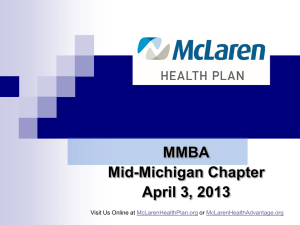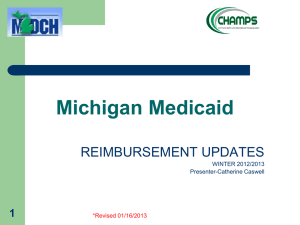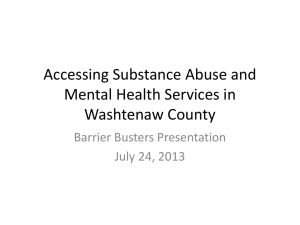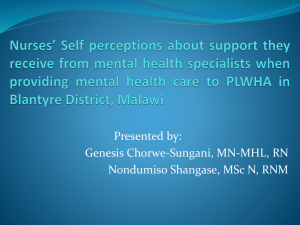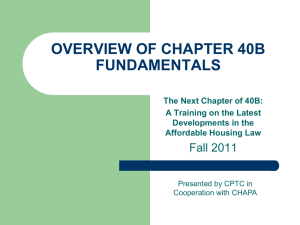Meetings - Michigan Health & Hospital Association
advertisement
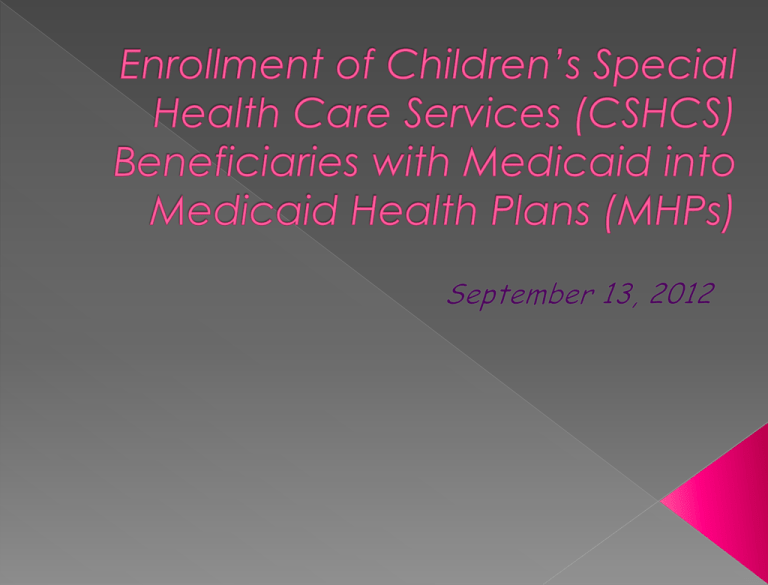
Welcome and Purpose: Steve Fitton Planning Process Update/Timeline: Kathy Stiffler Policy Bulletin Overview: Kathy Stiffler Core Competency Process: Kathy Stiffler Rates and SNAF: Brian Keisling Outreach/Communications: Lonnie Barnett Enrollment Process: Julie Denny Primary Care Provider Selection Process and Family Centered Medical Home: Dr. Jane Turner Care Coordination: Kathy Stiffler and Lonnie Barnett Prior Authorization Transition Procedures: Dr. Nina Mattarella Contract Administration: Kim Hamilton Performance Monitoring: Sheila Embry Discussion: all 2 Update children’s hospitals and pediatric regional centers on the State’s plans to transition CSHCS population with Medicaid into Medicaid Health Plans (MHPs) Provide an opportunity for Department to obtain input from hospitals and regional centers on transition plans 3 Approximately 21,000 children (and some adults) enrolled in CSHCS with full MA. Approximately 3,500 of this group will be voluntary for or excluded from managed care enrollment DCH estimates approximately 10 – 15 thousand CSHCS eligibles (CSHCS “look alikes”) are currently enrolled in the MHPs – not enrolled in CSHCS Data indicates that look-alike population has a lower acuity and expenses than CSHCS enrolled population as a whole MHPs do serve high acuity individuals – ABAD, CSHCS aged-outs, etc. 4 Budget for FY12 passed in May 2011 Sec. 1204. By October, 2011, the department shall report to the senate and house appropriations committees on community health and the senate and house fiscal agencies on its plan for enrolling Medicaid eligible children’s special health care services recipients in the Medicaid health plans. The report shall include information on which Medicaid health plans are participating, the methods used to assure continuity of care and continuity of ongoing relationships with providers and projected savings from the implementation of the proposal 5 In FY12, administration concurred that the planning process for transitioning this population required a more extensive planning and implementation process than the transition of other populations Therefore, implementation of the transition will take place in FY 13 6 The internal work group has identified several benefits to enrolling CSHCS beneficiaries into MHPs: Organized approach to primary care Addition of complex case management Ability for quality monitoring Access to outpatient mental health services Increased access to non-emergency transportation services 7 Following similar structure used to transition of other populations Department convened internal work group comprised of 25 state staff from CSHCS and MSA Meetings monthly as a group with additional meetings for subgroups on topics such as data, systems Department utilizing regularly scheduled monthly operations workgroup meetings with Medicaid Health Plans to discuss the infrastructure within the MHPs to successfully transition population Key staff from CSHCS, MSA and Enrollment Broker regularly attend 8 During internal and operations workgroups, staff and other experts are providing educational sessions on multiple topics relevant/unique to the transition of CSHCS population into managed care Contract requirements Care coordination Quality strategy CMS clinics CSHCS benefit package Family-centered medical home Prior/Authorization for DME, therapies, etc. 9 Department also making contact with key stakeholders such as hospitals, local health departments and CSHCS Advisory Committee to obtain input/feedback 10 11 Last two provider L-letters being finalized All providers, including out of state providers Transplant providers Member services training by CSHCS for MHP under development Coordination meetings with LHDs and CMS Clinics Final system changes are in testing phase System changes will go into CHAMPS on 9/28/2012 Outreach to CSHCS families and providers continues Monitoring of the CSHCS family phone line and Beneficiary HelpLine will begin in October 12 August 1: CSHCS stopped mailing applications to Medicaid beneficiaries also eligible for CSHCS; CSHCS eligible = enrolled in CSHCS for these beneficiaries October 1: MHP enrollees with new CSHCS diagnoses since 8/1 will begin in the CSHCS-MC benefit plan and the MHPs will be required to meet the special contract requirements October 1: Enrollment of UP CSHCS enrollees November 1: Current CSHCS/FFS enrollees in lower MI begin enrollment over 5 week period – begin with Kent County and end with Wayne County April 1: Conversion of MHP Enrollees meeting CSHCS eligibility criteria to CSHCSMC 13 Policy Bulletin issues 9/1/2012; effective 10/1/2012 Requires individuals who have both CSHCS eligibility and MA eligibility (CSHCS/MA beneficiaries) to enroll in health plan unless excluded for some other reason such as PPO insurance or incarceration MI Enrolls will conduct the choice counseling and process the enrollment into the MHPs Individuals have 90 days after enrollment to transfer to another MHP All providers MUST verify eligibility and enrollment status prior to providing services; CSHCS/MA beneficiaries will have CSHCS-MC listed as the benefit plan another with the name of the MHP in which the beneficiary is enrolled 14 MHPs must cover all Medicaid covered services specified in contract MHPs may have different PA requirements, formularies and documentation requirements All services currently carved out of MHP contract remain carved out; plus the following will be carved out effective 10/1: In-state approved intensive feeding clinic Drugs used to treat coagulopathies such as hemophilia Orphan drugs used to treat rate metabolic disorders 15 Following services continue to be covered by CSHCS and are not the responsibility of the MHP: LHD care coordination and case management Children's Multidisciplinary Specialty Clinic facility payment Orthodontia (for specific qualifying diagnoses) Respite Private insurance premium payment 16 Effective 10/1/2012 individuals authorized by FFS to receive PDN services are excluded from managed care enrollment 17 Access Standards Network Adequacy Referral Processing Performance Monitoring Grievance/Appeals Prior Authorization Family Involvement Overall MHP Performance 18 Core Competencies issued to plans: May 7 Decision by DCH that all plans that met core competencies would be required to participate: June 1 Core Competency submissions to MSU Institute for Health Care Studies due: July 2 Plans must be compliant with Core Competency requirements by: 8/31/12 Final documentation of compliance by 12 plans issued to DCH by MSU IHCS: 7/18/12 19 CSHCS-specific care managers Planning workgroups including community providers/hospitals PCP attestations built into provider contracts Special data analysis procedures No PA requirements for pediatric subspecialists Weekly reporting on CSHCS-specific issues/training needs Policies that specify coordination of DME with referring specialists and family CSHCS-specific DME complaints and grievances procedure 20 Quarterly focus groups with CSHCS members/families, member surveys, case management surveys, action plans to address internal and external concerns CSHCS/Family Ombudsman CSHCS Member Advisory Council Integration of behavioral health services Special care management procedures that include family involvement 21 Encounter and FFS claims experience from FY10 and FY11 associated with the CSHCS population was analyzed by consulting actuarial firm Milliman Data were both completed and trended 30 months from the claims/data year to mid-rate year of FY13 CSHCS population rates were developed using its own rate structure (base rate, regional factors, etc.) Rate structure and actuarial models for CSHCS are consistent with existing MCO rates CSHCS population split between Disabled and TANF populations with further divisions in the TANF group by age Children less than 1 (both Disabled and TANF) also have a unique rate cell based on their historically high costs 22 • • Specific carve-outs were identified for exclusion from the rates (dental services and certain pharmaceuticals) Beneficiaries receiving private duty nursing were excluded entirely from the rate analysis since they will not be enrolled in the health plans Adjustments made to include non-emergency transportation, HMO administration, amounts equivalent to FFS supplemental payments (GME, HRA, SNAF) and claims tax Stop/loss or risk sharing arrangements were investigated, but the decision was made to pursue a full risk arrangement for this population Rates were presented to MHPs and discussed at length Final capitation rates assumed managed care savings fairly evenly distributed across provider categories Rates were submitted to CMS in July for approval 23 • While all MHPs have different approaches for improving cost-effectiveness, some or all of the following elements come into play (this is a general discussion that is not CSHCS-specific): – Each member is assigned a primary care physician who is responsible for coordinating the member's care – Improved access to primary and specialist physician care reduces ER, outpatient, and inpatient hospital costs 24 – Coordinated care management: • Avoids duplicative lab, x-ray, and other diagnostic work • Avoids duplicative and conflicting pharmaceuticals • Promotes better communication between primary care and specialist physicians – Emphasis on preventive care and compliance with regimens improves health outcomes and lowers costs – Emphasis on prenatal care results in fewer intensive care babies and therefore lowers costs 25 – Intensive case management of Disability clients in particular improves health outcomes and lowers costs – Better access to mental health care reduces need for more intensive care from the mental health system down the road 26 Medicaid Health Plans (MHPs) have agreements with 6 Public Entities University of Michigan Wayne State University Michigan State University Hurley Hospital Oakland University Western Michigan University Amount is built into MHP capitation by MDCH to reflect historical usage of physicians affiliated with these Public Entities 27 If MHPs cannot provide the specialty services within their networks, this arrangement comes into play MHPs pay the Public Entities from the SNAF capitation component in proportion to the Public Entities' percentage of SNAF services provided The SNAF component is designed to reimburse Public Entity physicians up to roughly commercial rate levels and, in effect, supplements the amounts paid by the MHPs to the Public Entity physicians when the provider claim was paid 28 CSHCS Advisory Committee Correspondence to Families Initial letter Second letter Enrollment letter Welcome letter (new CSHCS enrollees) Family FAQs Family Focus Groups 29 www.michigan.gov/ cshcs Family correspondence, FAQs, and other materials Focus Group Report 30 Local Health Departments Regional Meetings Monthly Calls FAQs Visits to Large Health Departments Family Phone calls Family phone line Local Health Departments Provider L-Letters 31 Customized Letters for CSHCS Families: Michigan ENROLLS sends letter that has been customized for the CSHCS families and include a CSHCS dedicated phone line Dedicated Phone Line: Dedicated toll free phone number connects directly to Michigan ENROLLS staff specially trained to assist this complex population Specially Trained, Experienced Call Center Counselors: Experienced counselors with special scripts and desk reference materials and authorized provider information shared from DCH 32 Initial Extended Enrollment Timeline: Timeline for enrollment extended from 30 to 60 days is for the initial push of CSHCS beneficiaries into MHPs and allow for: CSHCS Customized Reminder Letter Phone Call to Families Assignment Process: Perceptive to the family’s needs, based on available information Are other family members on the case in a MHP? With what MHPs do the authorized providers participate? In the event of a tie the MHPs have equal weight and the assignment to the MHPs will be evenly distributed, taking into consideration MHP capacities 33 Capacities Capacity: Number of beneficiaries a Medicaid Health Plan (MHP) can adequately serve in a county. CSHCS capacity request is submitted by the MHP and reviewed by MDCH Capacities are monitored constantly to ensure adequate coverage in all service areas 34 CSHCS-MC enrollee with a provider who is added as an authorized provider: “This NPI is Listed….” message displayed. Access allowed to CSHCS Restrictions page: Indicates auth diagnosis codes and providers for DOS. 35 Eligibility Response Ex: Member Benefit Level page 36 Eligibility Response Ex: CSHCS Restrictions page to access authorized diagnosis codes and providers for DOS. 37 37 CSHCS-MC enrollee but the provider is not listed as an authorized provider: Beneficiary enrolled in MHP but the provider is not listed as CSHCS authorized provider: No access to CSHCS Restrictions page. “This NPI is Not Listed….” message 38 Eligibility Response Ex: Member Benefit Level page 39 39 PCP approval process – MHP list of approved PCP based on “attestation” Official PCMH certification (i.e. NCQA, PGIP) NOT required Family may choose PCP not on the list – family preference trumps all. Practice based care coordination Point person for care coordination Components of practice based care coordination – checklist from workbook Communication/coordination with MHP case manager, LHD coordinator, CMS clinic, subspecialists, mental health provider, schools. 42 Enhanced payment per member per month to compensate for extra effort for care coordination. Only approved PCP will receive enhanced payment $4 / $8 per member per month 43 Workgroup established including representatives from CSHCS, MSA, LHDs, and MHPs Workgroup charge: to develop a model whereby the care coordination activities delivered by the various providers be coordinated to assure that the family is receiving the necessary services and supports to achieve the best outcome for the beneficiary while avoiding duplication For care coordination/case management that results in a care plan, the goal is a single clear, comprehensive plan of care in which the families have input and can easily understand/follow Seeking electronic solutions for secure portal through which involved providers can access/update care plan 44 Current focus is on coordination of LHD/MHP coordination activities, but will soon include CMS Clinics. Coordination with FCMH practices is longer term Product: CSHCS Coordination Agreement template for use between MHPs and respective LHDs Base template can be modified to address the unique strengths and needs of each MHP and LHD as well as the communities they serve 45 For members not meeting complex case management criteria, plans typically provide: Assessment, individualized care plan development, prioritized goals and barrier busting Assistance obtaining needed authorizations for DME, therapies, or other ancillary services and arranging for timely delivery of these services Facilitation of transitions between levels of care or intensity of services Patient/family education, including role of family in the treatment plan/maintenance of member’s health status 46 For members not meeting complex case management criteria, plans typically provide: Appointment scheduling assistance Transportation assistance Referral to community and other resources– collaboration with LHDs 47 For members meeting complex case management criteria (e.g. complex medical needs/multiple comorbid conditions, high utilization of ED or inpatient, need for assistance in system navigation), plans are required by their accrediting bodies, to provide: Assessment and care planning within 30 days of identification of the member meeting complex case management criteria Plan’s procedures must address all of the following: Member’s right to decline complex case management Comprehensive assessment, including ADL, mental health, cognitive functions, life-planning activities, cultural and linguistic needs, caregiver resources, available benefits 48 Plan’s procedures must address all of the following (Continued) • Development of an individualized plan of care including longer and short term goals, resources, planning for continuity of care and transitions, family participation • Identification of barriers to meeting goals or complying the with plan • Schedule for follow-up communication with member 49 Plan’s procedures must address all of the following (Continued) • Development of member self-management plans • Process to assess progress against case management plans for members • In some communities, LHDs will assist with pieces of complex case management, assessment and care plan development 50 Level 1 Care Coordination is the development of a plan of care (POC) through the identification, documentation and organization of information regarding the health, social, familial and environmental circumstances and needs of the CSHCS client/family in coordination with the MHP The POC is organized with and for the family and is a resource document for families, provides and care coordinators 51 The LHD/POC must include: Client summary/assessment Dated list of problems/concerns Corresponding problem-specific goal(s) unique to each client/family, with family input Identification of appropriate intervention(s) and designation of person who will provide each intervention 52 Level 2 Standard Care Coordination consists of interaction with the CSHCS client/family and other involved with the care by the client by telephone, in person or in writing. Level 2 Care Coordination includes but is not limited to: Client advocacy Assisting with needed social, education or other support services at the community level Processing Children with Special Needs (CSN) Fund applications 53 LHD Case Management is designed for CSHCS clients with complex medical care needs and/or complex psychosocial circumstances LHD Case Management must be delivered in the home or other non-institutional setting of the family's choice and be provided face-to face in coordination with the MHP The Case Management POC must be developed by a public health nurse in collaboration with the client/family, in coordination with the MHP 54 DCH has developed a process to share active PA information in the system with the MHPs for the plan’s enrollees Providers must still submit a copy of the PA with the claim for services Three key areas: Transplants Therapies DME 55 Beneficiaries with a PA for a transplant will remain excluded from MHP enrollment until 30 days prior to the end of the PA MHP will work with the transplant provider to establish a new PA FFS PA will remain in effect for the first 30 days in which the beneficiary is enrolled with the MHP If the beneficiary is actively receiving a transplant or immediate post-transplant care at the time of the expiration of the PA, it may be possible to extend the PA and continue the beneficiary’s exclusion from the MHP. This will be decided on a case-by-case basis by a MDCH medical consultant using medical reports provided by the physician and hospital involved. 56 The MHP must accept prior authorizations (PA) in place for therapies when the CSHCS enrollee is enrolled into the plan If the PA is with a non-network ancillary provider, the provider will be reimbursed at the FFS Medicaid rate After 30 days the MHP may use its own PA procedures and network ancillary services 57 When custom-fabricated equipment (prosthetic or orthotic) is ordered for a beneficiary during a hospital stay but not delivered until discharge and enrollment changes, the payment must be made by the party responsible for the hospital stay When a custom-fabricated, -fit, or -modified service is prior authorized and ordered by the provider before a change of enrollment, the party that authorized the service is responsible for payment. DME must be delivered within 30 days 58 For non-custom DMEs and medical supplies, the MHP must accept FFS prior authorizations (PA) in place when the CSHCS enrollee is enrolled into the plan If the PA is with a non-network ancillary provider, the provider will be reimbursed at the FFS Medicaid rate After 30 days the MHP may use its own PA procedures and network DME and medical supplier services 59 There are various contract administration and performance monitoring mechanisms in place that the CSHCS population will be included in: Monthly performance monitoring HEDIS CAHPS Annual compliance reviews MDCH conducts assessment of health plans compliance with contract requirements and is planning a compliance review visit to each of the MHP’s serving CSHCS enrollees beginning in early June 2013 60 The 2013 compliance review focus study visit will focus solely on the MHP’s management of the CSHCS population and its ability to provide quality and coordinated care Physicians from the MDCH Office of Medical Affairs (OMA/CSHCS) will be attending these compliance review visits for a clinician perspective 61 DCH added contract requirements on several topics to ensure access to care and monitoring of the Role of MHP in providing data for CSHCS eligibility Maintaining continuity of care for primary and specialty care Following thru on FFS prior authorization for providers in and out of MHP network Special contracted network adequacy and availability requirements, including use of out-ofnetwork providers for providing services to CSHCS enrollees Maintaining Grievance and appeal process specific to CSHCS enrollees/ Separate reporting 62 Monitor and report performance against defined measures for CSHCS enrollees (e.g., HEDIS, EPSDT, inpatient admissions for ambulatory care sensitive conditions, and emergency department use). Special requirements for selection of primary care physician Requires special payment to Family Centered Care and Medical Homes Required to establish a contract between MHP and Local Public Health Departments Encourage to conduct special education and outreach to CSHCS enrollees Must provide Transportation, Meals and Lodging to all covered services 63 The CSHCS population will be included in the PMR and HEDIS data sets as they meet the specifications for inclusion The state currently conducts a Child CAHPS every other year: Child CAHPS for the MHP child population Children with Chronic Conditions (CCC) CAHPs for the CSHCS population Both CAHPS were conducted in 2012 and will be conducted again in 2014 We will be able to compare the results of satisfaction in the FFS CSHCS environment and managed care DCH will develop CSHCS-specific measures over the next fiscal year 64
